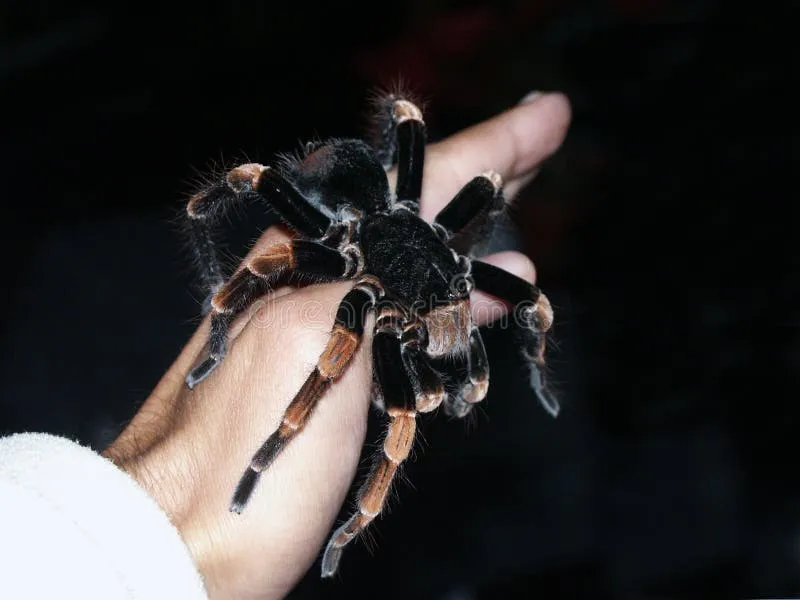Hand tarantulas are fascinating creatures, and owning one can be a rewarding experience. However, their care requires knowledge and responsibility. This guide provides the top 5 essential tips to ensure your hand tarantula thrives. From choosing the right species to understanding their behavior, we’ll cover everything you need to know to keep your eight-legged friend happy and healthy. Proper care not only ensures your tarantula’s well-being but also makes handling a safer and more enjoyable experience for both you and the spider. Read on to discover how to become a responsible and knowledgeable tarantula owner.
Choosing Your Hand Tarantula Spider
The first step in owning a hand tarantula is selecting the right one. Not all tarantula species are suitable for handling, and some are more docile than others. Researching and choosing a species that is known for its temperament and ease of care is crucial. Consider factors like size, venom potency, and defensive behaviors when making your decision. Start with species known for being less aggressive and easier to handle to minimize potential risks and maximize enjoyment.
Selecting a Healthy Tarantula
When acquiring a tarantula, always ensure you’re getting a healthy specimen. Look for signs of a healthy spider: a plump abdomen (indicating it’s well-fed), alert behavior, and no missing limbs. Avoid spiders that appear lethargic, have a shrunken abdomen (suggesting dehydration or starvation), or show signs of parasites or mites. Buying from a reputable breeder or pet store is highly recommended, as they can provide information about the spider’s history and health.
Identifying a Good Species for Handling
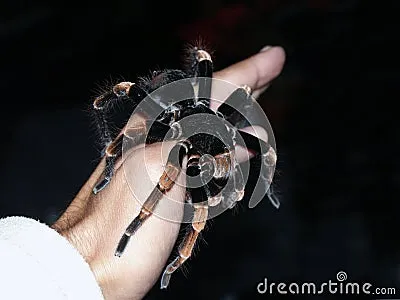
Certain tarantula species are known for being more docile and less prone to biting or flicking urticating hairs. Popular beginner-friendly species include the Chilean rose hair (Grammostola rosea), the Pinktoe tarantula (Avicularia avicularia), and some species of Brachypelma. These species are generally calmer and more tolerant of handling. Research the species’ specific care requirements before bringing one home to ensure you can provide the best environment for its needs. Remember, all tarantulas are individuals, so even within a species, temperament can vary.
Setting Up the Perfect Hand Tarantula Habitat
Creating a suitable habitat is vital for your hand tarantula’s well-being. A proper enclosure mimics the spider’s natural environment, providing a safe and comfortable space. The enclosure should be appropriately sized, well-ventilated, and equipped with the right substrate, decor, and environmental controls. The goal is to create an environment where the tarantula feels secure, reducing stress and promoting healthy behavior. A well-designed habitat is a key element to owning a happy and healthy hand tarantula.
Enclosure Size and Type
The size of the enclosure should correspond to the tarantula’s size. A good rule of thumb is an enclosure that is at least twice the spider’s leg span in width and length, and the height should be enough to prevent escapes and falls. For terrestrial species, horizontal enclosures are preferred, while arboreal species need taller enclosures. Glass or clear plastic enclosures are ideal, allowing for easy viewing. Ensure the enclosure has a secure lid to prevent escapes, as tarantulas are excellent climbers.
Substrate and Decor for Your Tarantula

The substrate is the flooring of the enclosure, and it plays a crucial role in maintaining humidity and providing a burrowing environment for terrestrial species. Good substrate choices include coconut fiber, peat moss, or a mix of both. The substrate should be deep enough for the tarantula to burrow if it chooses. Decor can enrich the environment. Provide hides such as cork bark, half logs, or artificial plants. These provide security and enrichment, reducing stress. Avoid sharp objects that could injure the spider. Ensure the decor doesn’t overcrowd the enclosure, leaving enough space for the tarantula to move and hunt.
Temperature and Humidity Control
Maintaining the correct temperature and humidity levels is essential for your tarantula’s health. Most species thrive in temperatures between 75-85°F (24-29°C). Use a heat pad or a low-wattage heat lamp to maintain the desired temperature. Humidity levels vary by species. Use a hygrometer to monitor humidity. Increase humidity by misting the enclosure with water, especially during molting periods. Poor temperature or humidity control can lead to health problems, such as dehydration or respiratory issues. Provide a shallow water dish, but make sure it’s not too deep to avoid drowning.
Hand Tarantula Spider Feeding and Hydration
Proper feeding and hydration are critical for a hand tarantula’s survival and growth. Feeding your tarantula the right amount of food and providing fresh water ensures it stays healthy. Adjusting feeding frequency based on the spider’s age and size is essential to prevent overfeeding. A well-hydrated tarantula is less prone to health issues and will be more active and alert. Providing appropriate food and water promotes a healthy, thriving hand tarantula.
Feeding Frequency and Food Types
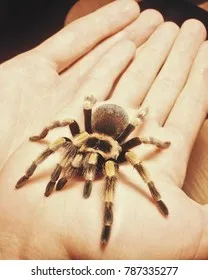
The feeding frequency depends on the tarantula’s age and metabolism. Spiderlings need more frequent feeding than adults. Feed spiderlings 2-3 times a week, while adults can be fed once a week or every other week. Appropriate food sources include crickets, mealworms, roaches, and other insects. The food should be roughly the size of the tarantula’s abdomen. Remove uneaten food within 24 hours to prevent mold and mites from growing. Never feed your tarantula wild-caught insects due to the risk of pesticides or parasites.
Providing Fresh Water
Always provide a shallow water dish with fresh, clean water. The water dish should be accessible but shallow enough to prevent the tarantula from drowning. Check the water dish daily and refill it as needed. For smaller tarantulas, you can provide water by misting the enclosure once or twice a week. Dehydration can be a serious health issue. Ensure the spider has constant access to water to avoid this.
Essential Care Tips for Hand Tarantulas
Caring for a hand tarantula involves more than just feeding and housing it. Safe handling techniques, recognizing signs of stress, and regular habitat maintenance are all part of responsible tarantula ownership. These practices promote your tarantula’s well-being, allowing for a safer and more fulfilling experience for both you and your pet. Incorporate these tips into your care routine to ensure a healthy and happy spider.
Safe Handling Techniques

Handling a tarantula is a privilege that should be approached with caution. Before attempting to handle, ensure the tarantula is calm and receptive. Never handle a tarantula if it shows signs of stress, such as raising its front legs or flicking hairs. Always handle the spider close to a surface, like a table or the ground, to minimize the risk of injury from a fall. Handle gently and avoid sudden movements. Wash your hands before and after handling your tarantula.
Recognizing Signs of Stress
Tarantulas exhibit various behaviors that indicate stress. Recognizing these signs is crucial for their welfare. Look out for: a defensive posture (raising front legs or fangs), flicking urticating hairs (a defense mechanism), fast movement, or hiding. If the tarantula displays any of these behaviors, it’s best to leave it alone. Stress can lead to health problems, and minimizing stress is essential for your tarantula’s well-being. Avoid sudden noises, bright lights, or any other environmental factors that could upset the spider.
Cleaning and Maintenance of the Habitat
Regular cleaning of the habitat is essential for maintaining a healthy environment. Spot clean the enclosure by removing uneaten food, molted exoskeletons, and any waste. Replace the substrate regularly, usually every 6-12 months, or as needed to maintain hygiene and prevent the buildup of harmful bacteria or mold. Clean water dishes frequently. The frequency of cleaning depends on the species, enclosure size, and feeding habits. A clean habitat reduces the risk of illness and keeps your spider comfortable.
Understanding Hand Tarantula Behavior
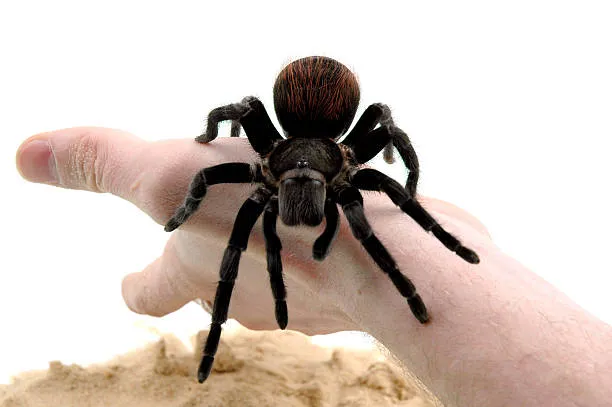
Understanding tarantula behavior is vital for responsible ownership. Observing their behavior and learning about their habits helps you provide the right care and handle them safely. Recognizing what is normal for your species and individual spider is key. This knowledge improves your handling experience and prevents stressing your pet. Learning about your tarantula’s habits will help you create a supportive, enriched habitat, which can benefit the tarantula. This can further strengthen the bond with your eight-legged companion.
Common Behaviors and Their Meanings
Tarantulas exhibit various behaviors that communicate their needs. A tarantula sitting still often indicates comfort. However, a tarantula raising its front legs or fangs is a defensive display. Flicking hairs is also a defense mechanism. Burrowing is a natural behavior for terrestrial species, indicating that it feels secure. Webbing indicates the spider is creating a safe space. Understanding these behaviors allows you to better respond to your tarantula’s needs and provide the right environment.
Handling Tarantula Species Differences
Handling practices vary greatly between tarantula species. Some species are inherently more docile and suitable for handling, while others are more defensive. Research the specific behavior of your species before handling. Arboreal species, for instance, tend to be faster and more prone to bolting or jumping. Terrestrial species might be slower but have more defensive behaviors. Always handle with care, and be aware of your species’ unique characteristics. Never force a tarantula to be handled if it doesn’t seem receptive.
Hand Tarantula Spider Health and Wellness
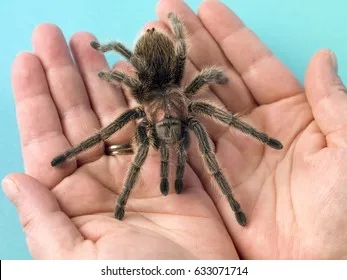
Ensuring your hand tarantula’s health and wellness is paramount to its longevity and happiness. This involves recognizing health issues and taking preventive measures. A healthy tarantula exhibits specific characteristics, like a plump abdomen, alert behavior, and a good appetite. Early detection of health problems can make all the difference in treatment and recovery. Proactive care and regular observation can prevent health issues from becoming severe. Prioritizing your tarantula’s health builds a strong, positive connection.
Recognizing and Addressing Health Issues
Common health issues in tarantulas include dehydration, mites, parasites, and injuries. Signs of dehydration include a shrunken abdomen and lethargy. Mites can be visible as tiny, moving spots. Parasites can cause various issues. Injuries can occur during molting or from falls. If you notice any signs of illness, consult a veterinarian experienced with invertebrates. Early intervention is often critical for successful treatment. Quarantine sick spiders to prevent the spread of illness to other pets.
Preventive Measures for a Healthy Spider
Preventative care includes providing the correct environment, appropriate feeding, and regular observation. Ensure proper temperature and humidity levels. Provide fresh water, and a varied diet. Inspect your tarantula regularly for any signs of illness or injury. Quarantine new tarantulas for a few weeks before introducing them to an existing collection. Maintain a clean enclosure, and remove uneaten food. By following these measures, you can help your hand tarantula live a long, healthy, and fulfilling life.
In conclusion, owning a hand tarantula can be a rewarding experience, provided you are prepared to meet its needs. By following these top 5 care tips, you’ll be well on your way to providing your spider with a safe, comfortable, and stimulating environment. Remember, responsible ownership includes understanding your tarantula’s specific needs, providing a suitable habitat, and handling it with care. With proper care and attention, you can enjoy the unique companionship of a hand tarantula for many years to come.
